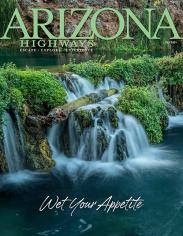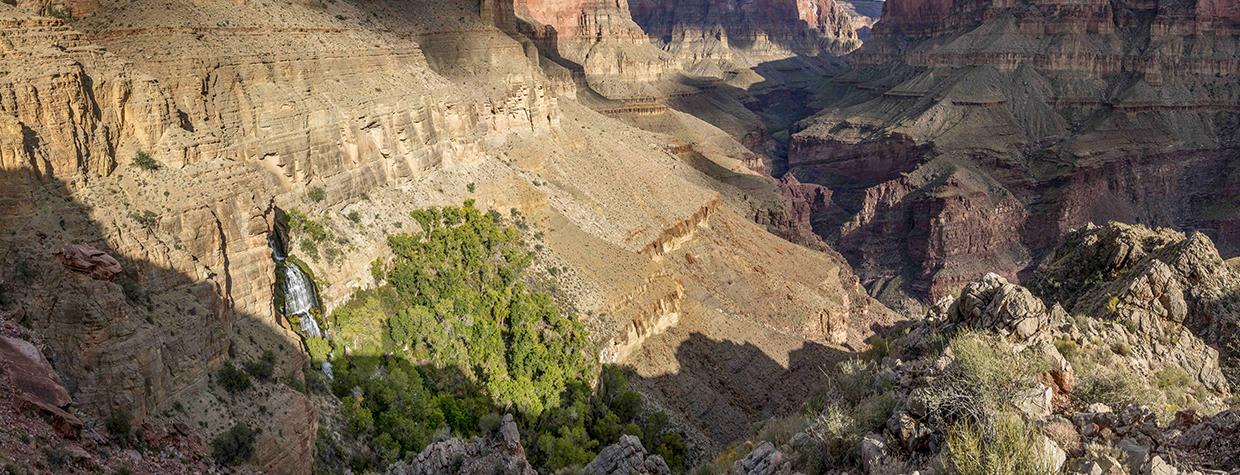Editor’s Note: The celebration of our centennial continues with another wonderful piece from another wonderful writer. This month, it’s Jonreed Lauritzen, who was our intrepid wanderer in Northern Arizona. “Lauritzen arises to lyric heights when he speaks of Canyon Country,” Editor Raymond Carlson wrote. “He makes you see and feel the country, its bigness, its grimness. He has spent most of his life in Canyon Country and few people know it as well, few have described it so expertly and in such vibrant language.” Writing was his destiny. “I didn’t think much of ditching and farming,” Mr. Lauritzen wrote. “I liked to read books. I read all of Shakespeare and Tennyson and Browning. I read Les Misérables and David Copperfield twice each. I had decided to become a writer. I had my first poem published at the age of 8. I never got over that first shot of the drug.”
WHEN YOU WANT TO KNOW the Earth — to hear the deep beat of her heart, to sense her innermost secrets, to grapple with her and feel her fearful breath, to wear the mark of the dragon’s teeth upon you forever — go down into Thunder River. Put a knapsack on your back, a blanket over your shoulder, a pair of moccasins on your feet. Be one of her children if you want to know the Earth. Otherwise, you might as well buy postcards and stay home.
But of course there are no postcards of Thunder River. If there are, they should be burned, for no picture, no words can do anything but pique your curiosity about it or any other part of the Grand Canyon. Once you have gone down into these places —
alone — pictures only bring you anguish and words are little hunks of lies. The trail to Thunder River leads off the North Rim from Indian Holler, which is near Big Saddle toward Crazy Jug Point, and that could be 70 miles south of Fredonia by way of Ryan ranger station. You leave your car at the corrals in Indian Holler (spelled Hollow) and walk about 4 miles up the holler. You then walk up the side hill on the south and you are at the top of the first rim, where you get your first reward.
Maybe it’s some after sunup and the Valley of Red Gold is spread out below, south and westward, flooded with a misty light that shines on the clean-washed sandstone terraces and takes the edge from the shadows of the dark canyons whose beginnings are directly below, south. It is a leisurely valley that moves off for 60 miles to a dim horizon in the west, where the Uinkaret Mountains slumber on the brink like black, lazy monsters that have crawled out of the canyons to sun themselves.
Looking down the Valley of Red Gold, you can imagine the time, several million years ago, when the Colorado wound unhurriedly along between the upper rims. There were cottonwoods and willows crowding its banks and birds ruffling the surface gilded by the desert sun. Even now, the valley floor looks that smooth and innocent in the far distance that you can almost see the billowing trees and the glistening water. It is in the foreground, where the lesser canyons make their beginnings, that you get some warning of the hideous deep gorge that writhes down the valley like the slash of a knife plunged to the hilt and drawn in swift curves along the full length of the wide hollow.
The rims that border the valley look deceptively low, being even along the top. It is when you get a fragment of them set off alone — like Jon’s Altar, midway down the valley — that you realize the majesty of these upper heights. The coloring and stratification are uniform all the way, the most striking feature being a cream-colored ledge through the center, the full length of the rims. Below this ledge all along are triangular splashes of magenta, where torrents have washed the rock debris off the lower stratum — so giving the illusion that the ledge is dripping with dark red.
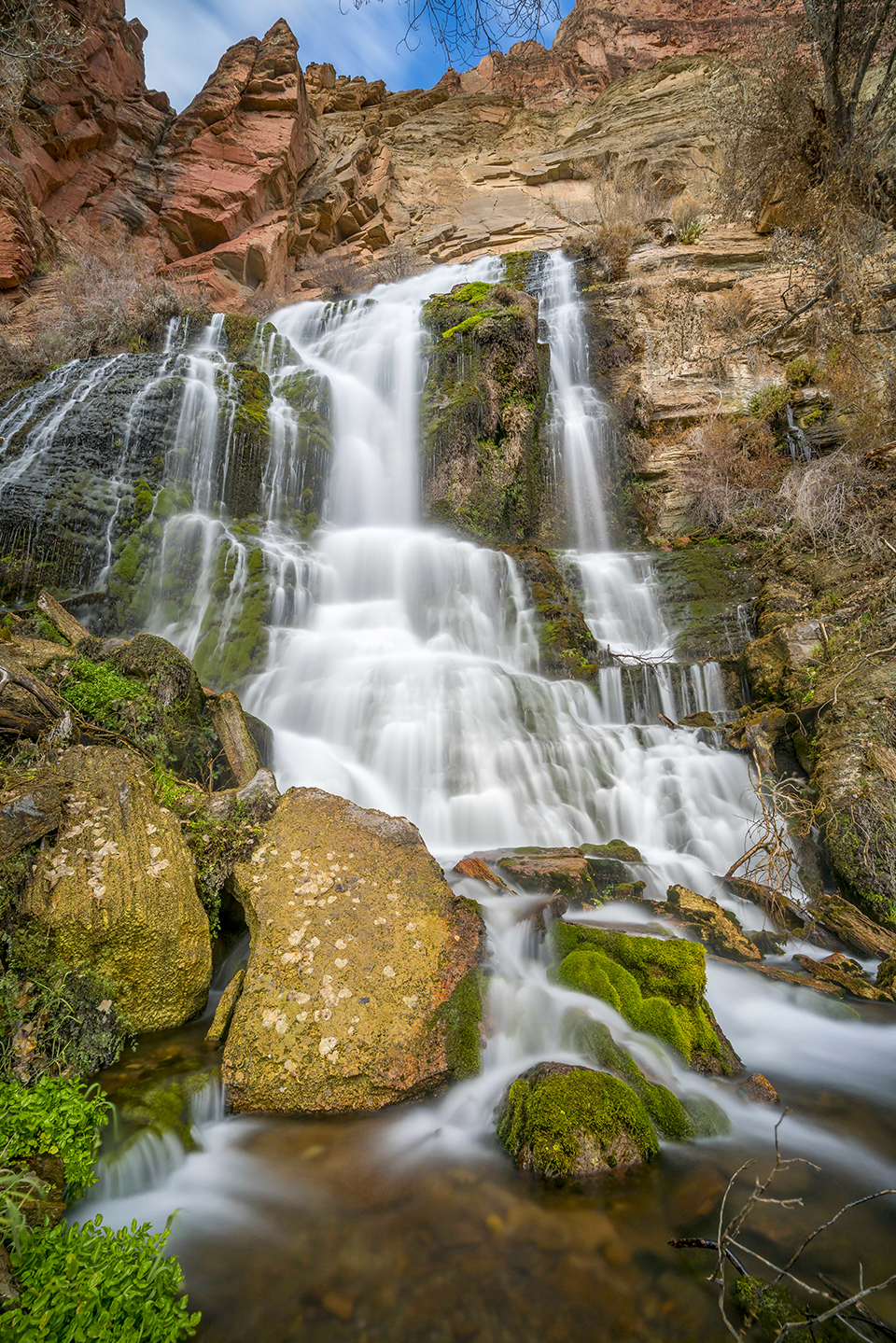
DOWN THE TRAIL you go now, in a long, rough, winding descent from the first rim. All the time you think you are going to plunge right off into the canyons ahead when you get to the bottom of the rim. But the trail doubles back several miles into a cove to the eastward under the rim. Then it lures you on over hillocks and around draws until your sweat-drenched frame begins to tire and you wonder if the one who told you the way to take might have not wanted you to hover forever on the lower rims like a lost imp.
If you are lucky, you will see the small slab of rock with the words feebly scratched on it: “Thunder River — This Way,” and an arrow pointing off to southwestward. That is the fork of the trails, one of which, if you can follow it, leads to Thunder River; the other takes you to hellan’gone. I took that one to hellan’gone and after some wandering came to a fence and a fading of the track and a realization that I had walked miles in the wrong direction. Even after I had trudged back, grinding the dust between my teeth, and found the slab sign and followed a trail that went in the direction the arrow pointed, this trail petered out on the solid rock and there was no way of telling where it went.
So, I dragged myself doubtfully down a holler where, according to the directions I had, the trail should have gone, but there was no trail anywhere — only enough track to lead one on to believe that someone, sometime, had been there before. Maybe it was a mountain sheep, maybe a wandering deer, maybe a cowpuncher looking for lost cattle and getting lost himself.
Mountain sheep or satyrs, I followed their ancient trace down into an abrupt canyon and then rimmed around above a thousand-foot wall that dropped deeper into that canyon, and I finally found myself on a peninsula jutting out into a maze of bottomless ravines. Before I could persuade myself to give up and go back, night welled up like black water from the depths and held me there. There was nothing to do but spend the night clinging to a narrow slope between an eternity of nothing below and a long, brooding cliff above. A step in the darkness here and you might be swallowed up, with nothing to tell of you but the faint echoing of your wail down the quiet canyons.
So, you hurriedly gather what brush you can from the almost barren slopes and light a fire. Then you sit, too tired, too lonely, too hungry even, to eat, and gaze out at the grim outlines of the rocks against the reddened wind-clouds in the west. You know that you have “come to the last path of the world, to the Scythian country, to the untrodden solitude.” The Earth is an emptiness, and the beat of your heart is the only rhythm of its silence. There is no wind. Even the gust of red clouds in the west has burned itself out. Only the stars are alive, and it is easier to believe that creatures live up there than on this gloomy Earth.
The Indians could well keep away from this gouged-out wilderness, peopling it with demons and gods. You can believe that fierce giant spirits stare out of the darkness as they stride along the rims. Your only protection against them is the fire, which itself adds a fearsome aspect to the seen, and frightful size to the unseen. It leaps up and sets the cliff above to jerking and twitching like the face of an old man in a nightmare. It flits across the black emptiness of the canyon, finding nothing to which it can cling, except the rocks on the opposite brink, which glimmer faintly if you care to look.
The brush is gone, the coals shrink to ashes, and there is not the faintest red glow to shield you from the presences that crowd upon the cliffs or reach up out of the abyss. You try not to think of them or of the canyon beside you. It is only a gap of darkness between brinks, you tell yourself. But it keeps coming back to you as you saw it in daylight, stretching down, down, until the trees at the bottom were little blurred splotches, and the more you try not to think of it, the more the Earth seems to be falling apart beside you.
Even here, your pulse ticks the endless hours away and there comes a suspicion of light above the rocks in the east. You can get up off your blanket and stretch your aching body, and look about for brush to make a fire.
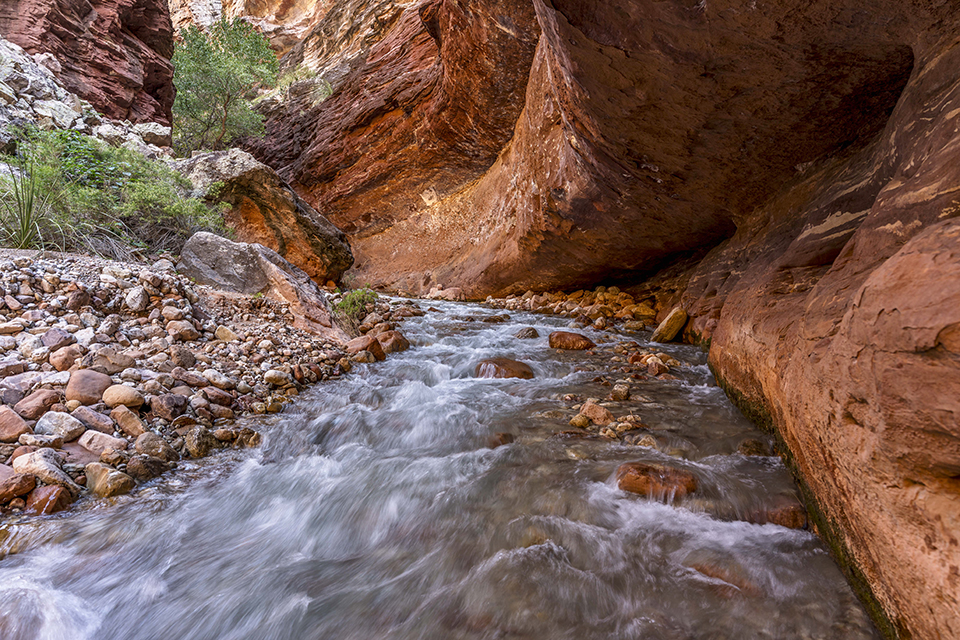
THE TRAIL, WHEN YOU FIND IT, leads down a long sandstone ridge westward and you come back toward to within a quarter-mile of where you spent the night. If you had known what you now know, you could have avoided that experience of the long night. But you have no regrets, since it is over. It has made a rich page for your book of life.
At the head of the next jump-off, you can look back over the red sandstone ridges and draws and see the slope where the trail you took yesterday morning comes down through the cream-colored ledge of the upper rim. Since then, you have come in a great horseshoe bend — not counting your unnecessary wanderings. If you could have come straight across to here from that first rim, it would not have been more than 3 miles, but you have gone 20. You have put a thousand years of wandering and thinking and feeling into that horseshoe of red-gold.
Now, at the brow of the next descent, you forget yesterday, last night. You have mind only for what is ahead and far below. A sharp fall of 1,500 feet will take you to Suprise Valley — a desolate little black saucer of earth left in the bend of the Grand Canyon when the Colorado turned westward, shortened her course by digging against the south wall. This Suprise (yes, that’s the way we say it) Valley was used in some of Zane Grey’s books. Here the hero and heroine of Riders of the Purple Sage are said to have locked themselves in forever by dislodging a giant boulder at the head of the trail, where you now stand. Author Grey must never have gone down into Suprise Valley himself, or he would never have left even a brain-child there. Scarcely a living thing is to be seen in the valley, only greasewood brush and some wild flowers.
Down you go, the trail spiraling through a break in the flintstone ledge. The way is littered with bright-colored fragments — red, brown, blue, black, striped. A lover of these stones would kill himself lugging pocketsful, knapsacksful, out of here, and across the horseshoe bend and up the highest rim. For you it is a minor temptation. You came to see Thunder River Canyon.
Already the shadows are crawling up out of the lower gorges and fingering the eastern walls. But if you can hurry down the trail without breaking a leg, you may reach the east edge of Suprise Valley before the final shadows close in. Maybe you can make it down into Thunder River Canyon before dark, for it looks like it might be only a hop-skip-jump from the edge of the valley. Night almost catches up before you get to the edge, and here the surprise of Suprise Valley lies in wait for you.
Yes, it is Thunder River Canyon, but nobody could have told you what, at this moment of gathering dusk, you were going to see. If the human mind were capable of such a thing, you might have imagined it, but the human mind cannot even grasp what it sees here. You know something of a Grand Canyon, which is magnificent, deep, splendid beyond words — at times terrifying in its sheer depth and height, as at Toroweap, but always clean-cut and beautiful in its boldness.
Well, that is not the kind of canyon you are seeing now. Maybe the upper walls of Thunder River, too, have nobility and beauty, but you are blind to it now. The thing you see is a lower gorge that shows Earth in an agony too gross and cruel and ugly to conceive. The river that has done this thing is still invisible far below, but you can hear its growlings and whinings echoing up from the jagged red-brown chawn-hole it has made. It has bitten a ghastly wound, drawn its teeth in a long, deep, narrow slit. In another moment of a million years, maybe, the frenzied little beast of a river will have ripped through the last tissue and laid bare the bleeding vitals of the Earth.
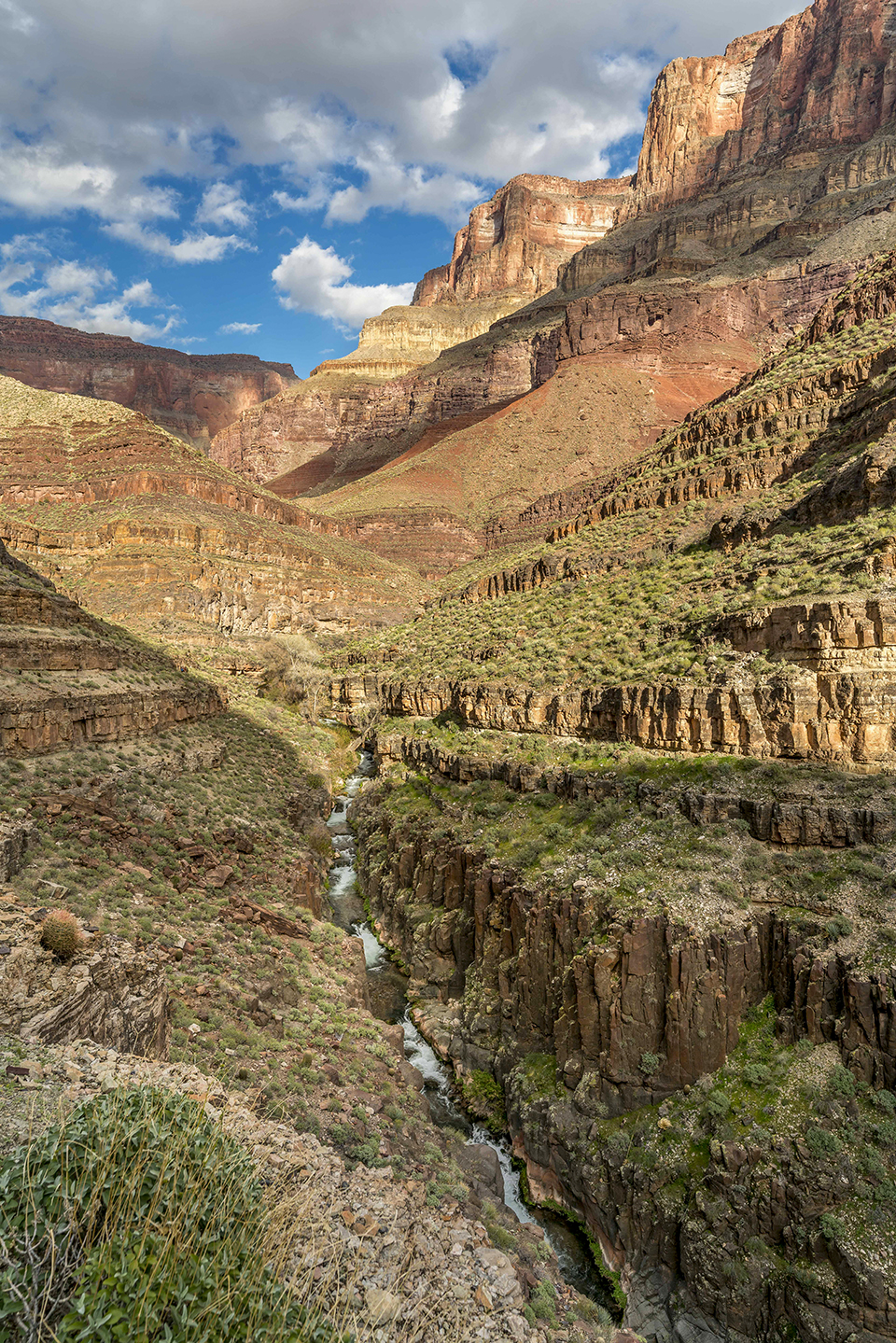
You turn away. Even if there were enough daylight left to see you down whatever trail might lead into that gash, you would not tackle it. You gather dry greasewood and get a fire to blazing behind a great mound of rock that will stand between you and Thunder River Canyon. You burrow into your pack, eat what you can, then get up and gather more brush. There is a small bush that burns brightly, and you gather a lot of it in spite of the stickers.
By its light, you smooth out the sand for a bed and unroll your blanket. It is a place to lie and watch the fire, but you know you will not sleep. This is not fatigue as you know it, not the clean weariness that brings quick sleep. It is something mixed of aching and loneliness; maybe not fear nor dread nor unbelief — maybe not.
It is almost a surprise that dawn can come again. The first night it was a miracle. This night it is beyond faith, but it does come after you have practically laid bare the east end of Suprise Valley gathering brush for your fire. Before it is light enough to see the trail very clear, you are on the way, your feet feeling the rocks carefully.
Sunup ignites the cliffs to a luminous amber. Now all the dread of the night before is gone. The gorge below is still dark and jagged and fierce, but daylight shining on the torn ledges takes away their sinister spell.
A short way down and you come to Thunder Creek, a sight that cheers your lonesome mind as it does your thirsty body. You are tired of the stale, insect-filled water in the rock pockets. Here is something clear, cool and clean as anything right out of the bosom of the Earth can be.
Leaping out of a hole in the base of a thousand-foot wall, Thunder Creek first spreads a white foaming sheet down over a ledge festooned with maidenhair ferns and lichen, then dives ecstatically over swiftly successive cliffs and terraces, now blue-white with wings stretched out, now gathering itself in a body for another flight. Never is it anything but a rushing, tumbling, frothing thing, too lost in its hurried ferment to spare you even one quiet edge where you can put your mouth to drink. When you do drink, it is like drinking from the spout of a seltzer bottle.
Trees are clustered on the narrow terraces, half-veiling the wild dance of the little river, and wherever any soil can cling, the walls and terraces are draped with ferns, rushes, tall primrose. There is a strange Mimulus [monkeyflower] with rich green leaves and rare, crimson flowers. Where the ferns march bravely up to the edges of the torrent and put their feet into the water, their wavering roots under the surface show salmon red.
It is odd to see these flowers and the luxurious green foliage nodding patiently under the endless spray, while not five steps away from them are desert shrubs and flowers sending thirsty roots into the hot, dry hillsides to search out any trace of moisture. Desert and aquatic gardens side by side — worlds away in nature, yet only a foot or two in space. But the queerest thing is that the flowers struggling on the arid, sterile hillsides are the ones that fill the air with fragrance, while the semi-aquatic plants either give off no scent or have it drowned in the spray.
Excitingly beautiful as it is, you do not stop long at Thunder Creek Falls — Fresco Falls. The thing you came to see — Thunder River — keeps tugging at your consciousness from way down below, but all the while you descend, Thunder Creek skips along beside, filling your ears with its husky whisper and occasional roar.
You can take any of a thousand turgid mountain streams in the world, and you’ve got Thunder River. It isn’t simply that light blue water whipped into a perpetual froth that makes Thunder River. It’s the red-brown gorge it has torn out at the base of cliffs and terraces piling up for nearly a mile into the sky that makes Thunder River something to remember.
Thunder Creek jumps like a gleeful little brother into the arms of Thunder River, and together they go hurrying along toward the Colorado, singing and talking and in some places making an awful uproar. If you want to go along, you just about have to be one of them, for sometimes the banks rise sheer on both sides and where there are narrow floodplains they are covered with a thicket of willows and dense undergrowth. You will have to climb out and do some rimming around to avoid falls.
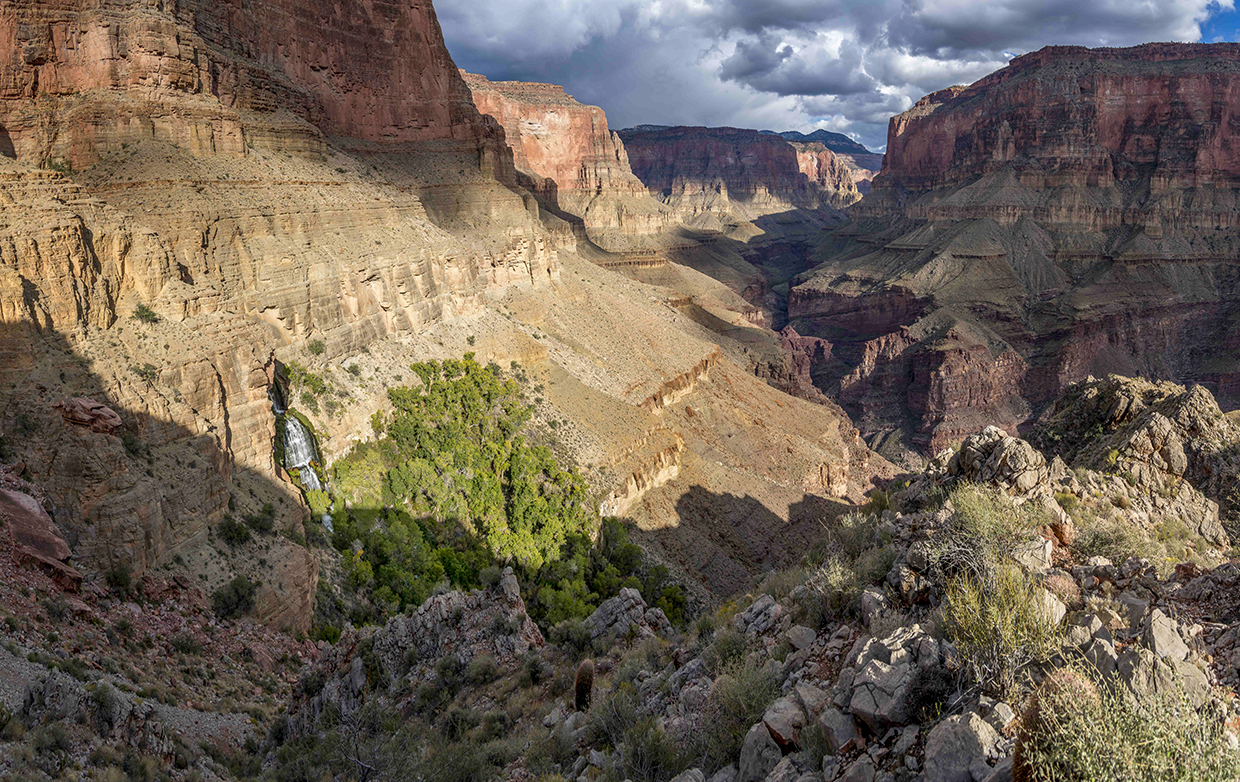
Where Thunder River pours into the Colorado, the latter makes a big bend and runs westward after having come 20 miles or more in a course almost directly north. Gulping up Thunder River, which looks so clear as to be almost black, against the beige of the big stream, the Colorado moseys along with a contented look on her face — like the cat that just ate the canary — and heads into the gorge that winds deep between the walls of the Valley of Red Gold.
Just before she gets to the narrow gateway, she begins to hurry and make small sounds, anxious or angry. Her hackles are rising as she scents excitement ahead. For 50 miles or more she will be alone, 3,500 feet below the valley, where she can leap and writhe and snarl and snap at the cliffs in playful fury, with no one to see her but the grinning Indian gods.
You might rim around the first ledges coming back from the Colorado to your camp at Thunder Creek, and if you do, you may run onto an old trail, built no-one-knows-how-long-ago. It follows the easiest possible incline and is said to begin — or end — at Bonita Creek, which is on the west side of Suprise Valley. The trail was carefully made and graded, as the retaining walls still testify. It was made for beasts of burden, or maybe for men heavily laden. It was made to carry something out of the canyon, but what and by whom? Early Spanish gold hunters?
After you have rested from this 4-mile journey — a good day’s hike — to the Colorado River from the forks of Thunder Creek and Thunder River, there may still be something unbeaten in you. A further desire for exploration can be considerably flattened out by a trip to the head of Thunder River. Take a day for it, and wear canvas or other light shoes for heavy going. You will be in water most of the day, but don’t try to insulate yourself against it with rubber boots or waders, for they will wear you out. They will be useless anyway, for you will be up to your beltline in water at times. You can’t stop to dry your clothes, either, if you want to make it back to camp for night.
You will go between narrow walls dark as a tunnel, with a choice of inching along a narrow shelf of rock above the swift water, or breasting the water itself, where you might be swept off your feet and carried down to shallower places. For the sake of your camera, you will try the shelf.
Many times you will be rewarded for the risks you take, for the narrow walls will open onto vistas of foaming water, ferns and Mimulus, cottonwood and birch, all bathed in shining vapor that adds to the mystery and beauty of the rose-hued cliffs that rise sheer and immense on every side. And you will drink in the symphony of odors: the damp, pungent smell of the rocks, the heavy fragrance of myriad flowers on the banks and the steep hillsides, the subtle breath of aromatic herbs drenched in the swirling mists.
Maybe you will have been told, as I was, that Thunder River comes pouring out of the side of the canyon and falls 150 feet or so. To see that fall will be one of the main reasons you will have for making this tremendous trip up Thunder River. I went to get a picture of it, for no one has ever photographed it that I know.
Now, Thunder River has plenty of minor falls and rapids. All she does is tumble and roar and leap. As for the 150-foot falls, here is another mystery. Ed Lawes of the National Park Service will tell you it is there. Raymond Pointer and Reese Locke are positive about it, for they have seen it from the top of the cliffs. They tell how a party of them took turns lying down and stretching far out from the edge of the cliff to look, while the others held their feet.
Not many — perhaps two or three — have actually gone along the river to its source to see where it came out. I am one who followed the river all the way. Paul Kernodle of Kansas City is another. We can testify that there is no such fall as the others describe. Thunder River springs mildly from among the rocks at the bottom of the canyon, a half-mile or less from the canyon’s head.
The only explanation so far given for this “Now-you-see-it-now-you-don’t” Fall is that it may possibly dry up after a long season of drought. It is said that Thunder Creek is at times dry.
Anyway, in the early spring, when the Kaibab snows are melting and all the underground channels will most likely be full of water, I am going back to Thunder River. I will sneak very quietly up toward the head and catch this fall, if I can, in the very act of falling. Want to come along as a witness? Come on!
